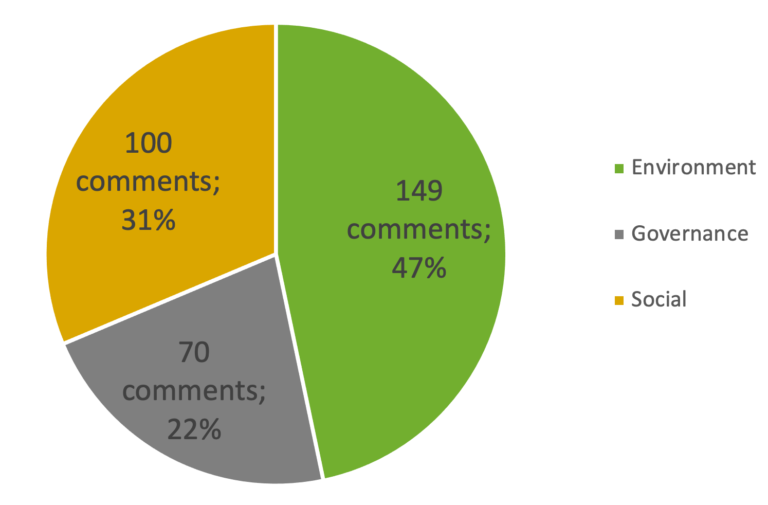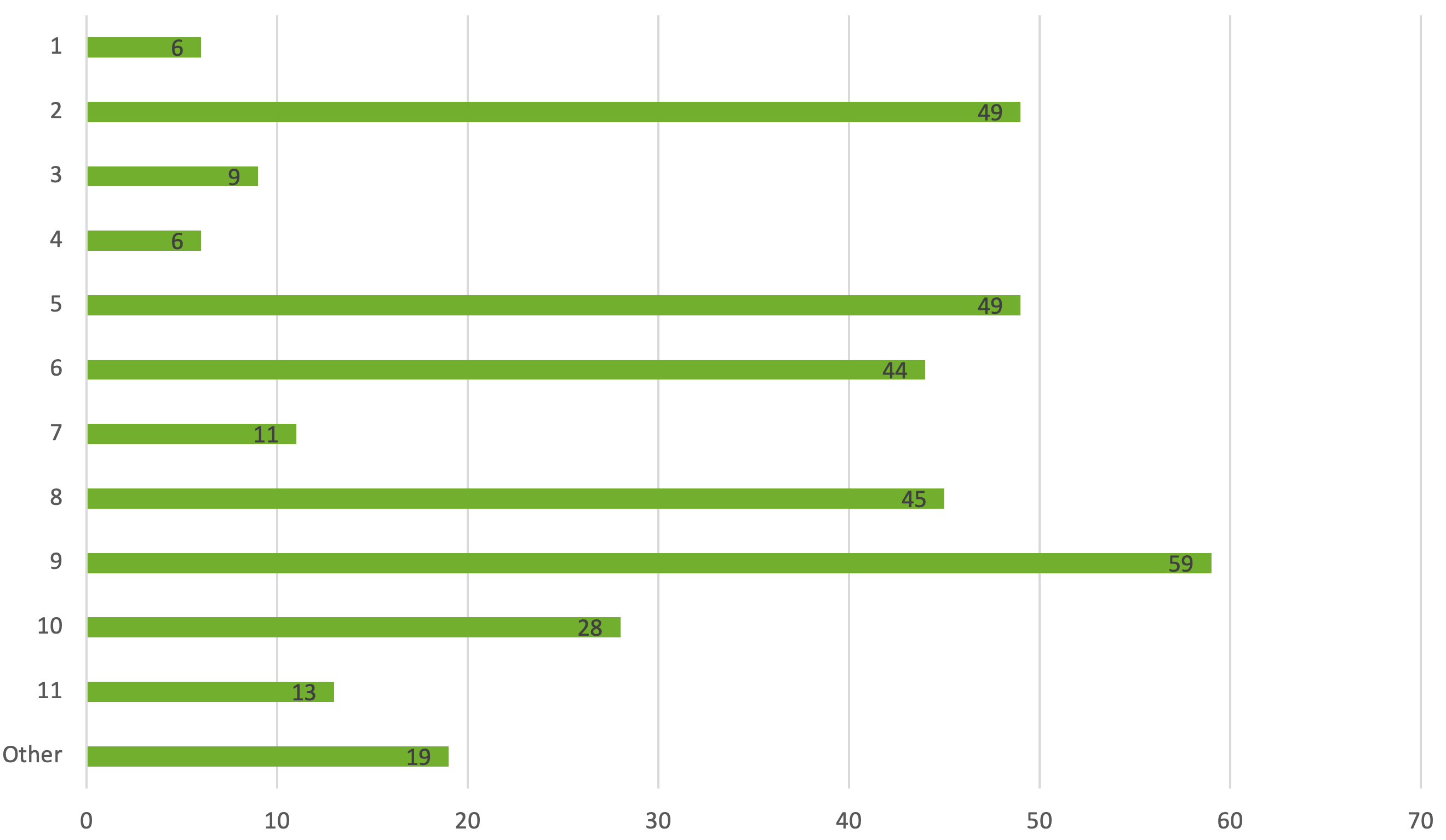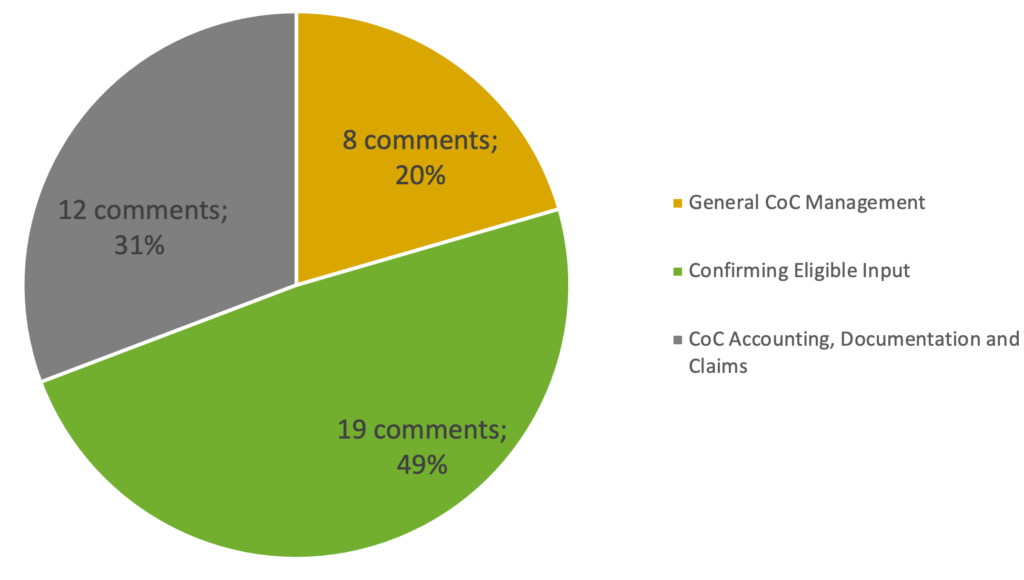Data & Research Insights: Statistics and overview of the ASI Standards Revision Public Consultation
Key takeaways from the second and final consultation:
- ASI Secretariat received 490 comments in total (448 without counting duplicates)
- Out of 448 comments, 75% referred to Performance Standard, 11% – CoC Standard, 8% – Assurance Manual, 5% – Glossary, 1% – All ASI Documents
- Under the Performance Standard, Environmental topics received the highest number of comments (47%), followed by Social (31%) and Governance (22%) sections with Principles 5 – GHG Emissions, 9 – Human Rights, and 2 – Policy and Management collecting most feedback
- Under the Chain of Custody Standard, the section on Confirming Eligible Inputs was most commented (49%), followed by CoC Accounting, Documentation, and Claims (31%), and General CoC Management (20%) with Principles 1 – Management System and Responsibilities, 4 – Recycled Aluminium, and 8 – Mass Balance Percentage System collecting most feedback
- 93% of comments were closed and only 7% scheduled to be discussed Post-Revision
- Received feedback demonstrates that the stakeholders’ interests align with the ASI’s new Strategy and 2030 Sustainability Priorities.
The second and final public consultation ended on 6th February 2022 after a period of 30 days. ASI Secretariat logged 490 items for discussion by the Standards Committee.
Out of 490 comments, 42 were repeated by multiple commenters, indicating co-operation among commenters, potentially reflecting the importance of the issues raised. Further in this analysis, when discussing received comments, we refer to the number of comments without duplicates (448).
The highest proportion of comments referred to the ASI Performance Standard (75%). This could be expected as it is the main ASI Document addressing environmental, social and governance sustainability issues in the aluminium value chain around which the whole ASI Certification program is built. The comments show a genuine interest from a broad group of stakeholders to keep the Standard’s Criteria relevant, fit for purpose and future-ready to drive the long-term improvement of the sector.
The remaining 25% of comments were spread between the ASI CoC Standard (11%), Assurance Manual (8%), Glossary (5%), and all ASI Documents as a whole (1%). In the figure below, the number of comments by each ASI Document is additionally broken down by the type of change proposed: Specific, General, Editorial; with the highest proportion of Specific comments providing specialized input for each ASI Document.

Figure 1 Comments by ASI Document and type of comment
Received comments were submitted by 7 different Stakeholder groups, with Businesses covering Production and Transformation activities sending the most (35%), followed by Civil Society (21%). The high number of comments from the Businesses with Production and Transformation activities reflects that this is the largest ASI membership class in terms of member numbers. Through their contributions to the Standards Revision, ASI Production and Transformation have actively contributed their specialized knowledge and experience of the industry to continuously contribute to the improvement of the ASI Certification program and simultaneously their own ESG performance. Similarly, the Civil Society contributions are critical for deep expertise in sustainability topics and understanding evolving stakeholder expectations.

Figure 2 Received comments by stakeholder group
*Other = Anonymous.
All ASI Documents
The overall feedback for all ASI Documents was that the documents should be clear in the specifications, avoid ambiguity but at the same time, the Guidance text for the Performance and CoC Standard, as well as Assurance Manual, should be shortened. This, as mentioned in several other comments, could be supported by the alignment of the terminology used (e.g., related to Child Labour, Forced Labour, restriction of the freedom of movement of Workers, etc.) and requirements (e.g., Effectiveness criteria for the Complaints Resolution Mechanisms should be aligned with the effectiveness criteria elaborated in the UN Guiding Principles) with the other internationally recognized Standard bodies (e.g. ISO) and disclosure frameworks (e.g., GRI, CDP).
ASI Performance Standard

Figure 3 Comments by ASI Performance Standard Section
For the ASI Performance Standard 338 comments have been logged, out of which the highest share was attributed to Environmental topics (47%), followed by Social (31%), and Governance (22%).
Looking more closely at specific ESG issues, Principle 9 on Human Rights, Principle 5 – GHG Emissions, and Principle 2 – Policy and Management were most widely discussed. The number of comments on Human Rights and GHG emissions demonstrates stakeholders’ awareness of the importance of transparency, accountability, and urgency to act on these issues in order to drive sector-wide climate change mitigation and adaptation with respect of Human Rights.

*Other = Introduction and Appendices
The list below includes examples of most commented issues and suggestions for inclusion:
- Inconsistency regarding timelines for reviews of Policies and public disclosure of performance data
- Need for the independent verification of the publicly disclosed GHG emissions
- Target thresholds for the Aluminium Smelter GHG Emissions Intensity:
- Possible Audit outcomes: Non-Conformance, no Certification granted
- Provisions for already Certified Entities
- Pathways rather than targets for specific year
- Applicability of Management Systems for specific issues i.e. GHG emissions, Emissions to air, Biodiversity management, OHS:
- Delegation of Management Representative to lead the implementation and communication of the Environmental, Social and Governance Policies
- GHG Management System should be aligned with GHG Emissions Reduction Plan and targets
- Management of Priority Ecosystem Services should be documented and implemented measures included the Biodiversity Action Plan
- Biodiversity management and ambition to achieve ‘no net loss’ in relation to the negative impacts of development projects on biodiversity and ecosystem services
- Moving from cooperation to participation: Communication of Management Plans, relevant certification audit processes and public disclosure of performance data, including communication with Indigenous Peoples and Affected Populations and Organisations
- Meaning of Historic Aluminium Operations in relation to Human Rights Impacts Assessment, Mergers and Acquisitions
- FPIC of the Indigenous Peoples; impacts on Indigenous Peoples specifically with regards to physical and economic displacement
- Working Time and Remuneration (ways to calculate time, what constitutes a salaried worker)
- Factors based on which Indigenous Peoples should be identified
- Unclear definitions:
- Customary Law
- Materiality/Material Impacts
- Indirect GHG Emissions: what categories of scope 3 are covered
- Conflict-Affected and High Risk Areas (CAHRAs).
ASI Chain of Custody Standard

Figure 5 Comments by ASI CoC Standard Section
The ASI CoC Standard received 46 comments, out of which 49% referred to Confirming Eligible Inputs, 31% to CoC Accounting, Documentation and Claims, and 20% to the General CoC Management section. As the purpose of this Standard is to assure responsible production and sourcing of Aluminium through the implementation of the CoC Standard supported by the documented flow of the CoC Material along the aluminium value chain, it is of no surprise that most feedback focused on the Principle 4 on Recycled Aluminium: Criteria for Eligible Scrap, Principle 8 – Mass Balance System: CoC Material and ASI Aluminium, and Principle 1 – Management System and Responsibilities.

Figure 6 Comments by ASI CoC Standard Principle
Main issues which according to stakeholders required more clarification include:
- CoC Material Flows annual reporting under Criterion 1.7:
- Reporting period
- Means of reporting data to ASI
- Validity period of the Positive Balance
- Identification of aluminium containing wastes: aluminium recovered from dross and treated dross residues under Eligible Scrap
- Specification of Material Flow quantities to be reported annually to ASI Secretariat.
Assurance Manual
As presented in the Figure 1, Assurance Manual received 8% of all comments submitted.
The list below includes key issues stakeholders identified as requiring more clarification:
- Lack of alignment between timeframes for the Performance and CoC Standard surveillance audits between documents
- Completion of audits
- Granting of the High Maturity rating
- Obligations resulting from Non-Conformances
- Guidance for auditors on how to facilitate Audit interviews with stakeholders and Indigenous Peoples.
Next steps
Out of 448 comments, 93% were solved either by direct ASI Secretariat implementation, or through discussions with the Standards Committee, or identification as not relevant where no change had to be made. Mostly due to the time constraints and complexity of some of the topics, the remaining 7% was scheduled to be discussed within the ASI Secretariat, Working Groups and Standards Committee once the Standards Revision process is finalized and all documents are published in May 2022.
Examples of topics to be discussed Post-Revision are as follows:
Performance Standard
- Additional guidance on how SMEs can implement the Performance Standard
- Meaning of Historical Aluminium Operations
- Consideration of a ‘Just Transition’ when New Projects or Major Changes are scheduled
- ASI endorsed methodology regarding Entity-level GHG Emissions Reduction Pathways
- Applicability of the Biodiversity Impact Assessment
- Physical and economic displacement: introduction of the baseline socio economic surveys, and post resettlement surveys
- Disclosure of water related impacts particularly for water stressed areas
Chain of Custody
- Inclusion of Bauxite Residue as an Eligible Input
Assurance Manual
- Public availability of the full ASI Audit Reports
Claims Guide
- What claims a trader can make related to the CoC Material

Figure 7 Completion Status
The aim of the Standards Revision was to provide the opportunity to clarify and improve ASI’s certification program based on implementation experience and identified improvement areas, stakeholder feedback and evolving expectations, and good practice approaches in certification programs and data governance. Based on the consultation feedback received, ASI believes that all aims were achieved. Additionally, this analysis show that the main interest of different stakeholder groups aligns with the ASI’s new Strategy [link to the website] and 2030 Sustainability Priorities which focus on driving sector-wide climate change mitigation and adaptation, material circularity, nature-positive action, all with respect to human rights.
With that in mind, following the publication of Revised Standards, ASI Secretariat and the Standards Committee will explore further refinement of Guidance material (with a more regular, defined schedule of updates) and to tackle multi-year criteria development, aligned with the ASI’s Strategy.


